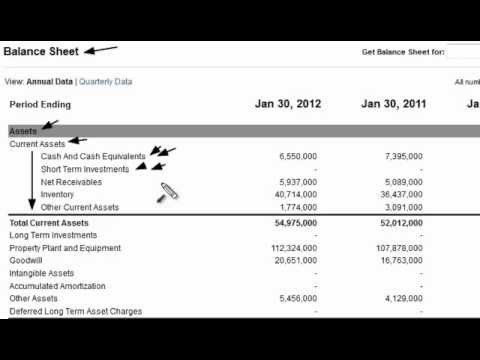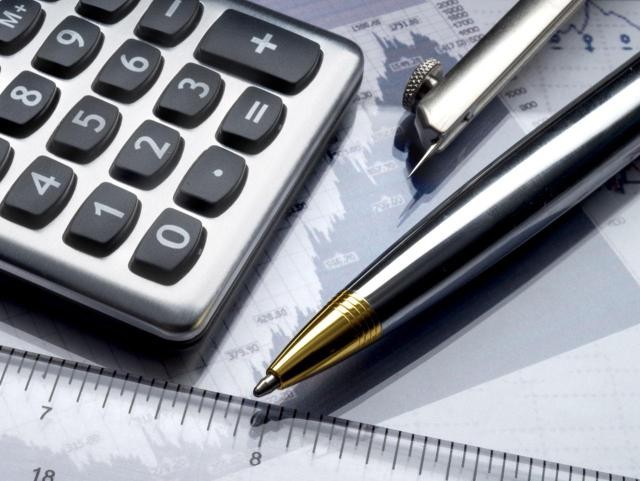What Is a Balance Sheet Stock Investing 101
Post on: 30 Май, 2015 No Comment

NEW YORK ( TheStreet ) — The company has a superb balance sheet. The balance sheet is solid. The balance sheet remains steady. The balance sheet. When it comes to stock analysis, it’s something that’s referred to a lot. But why?
Simply put, the balance sheet is one of the most important financial documents you can use to evaluate a company’s fundamentals ( Getting Started: Fundamental Analysis ). As one of the principal corporate financial statements, the balance sheet’s job is to essentially tell investors where a company stands financially.
The balance sheet consists of two main sections: first, assets (usually presented on the left) and second, liabilities and shareholders’ equity (usually presented on the right).
A company’s assets consist of anything it owns that has real financial value. The liabilities and shareholders’ equity (also known as owners’ or stockholders’ equity) section represents the ways that those things were paid for. Liabilities are anything that a company owes to someone else; bank loans and bond issues are common examples.
Shareholders’ equity consists of the company’s stock (the kind you might have in your own portfolio) as well as the income the company holds onto from operations, called retained earnings. Each of these — liabilities, stock proceeds and retained earnings — can be used to purchase the assets listed in the other section of the balance sheet.
Assets = Liabilities + Stockholders’ Equity
The above accounting equation is what makes the balance sheet balance. It’s one of the original concepts in financial accounting: A company’s assets are equal to its liabilities plus its stockholders’ equity. It makes sense. Think about it: A company can’t buy stuff without taking out a loan or selling enough stock to pay for it.
The accounting equation holds true for a business on any scale — even a kid’s lemonade stand. With $10 spent on lemons and sugar and another $5 borrowed from Mom and Dad to paint the stand, a kid’s lemonade stand balance sheet might look a little like this:
Assets
Supplies inventory: $10
Property and equipment: $5
Total assets: $15
Liabilities and Stockholders’ Equity
Liabilities: $5
Shareholders’ equity: $10
Total liabilities and stockholders’ equity: $15
Even though the kid spent that $15 on his or her lemonade business, that amount remains on the books, both in the assets section (since the drink-making supplies are still on hand until the drinks start selling) and the liabilities and stockholders’ equity section (money the kid put into the company is his or her equity, and the kid still owes Mom and Dad that $5).
The Balance Sheet: Assets
Back to the real world and the assets section of the balance sheet: Some common assets you’ll likely see in this section are cash. accounts receivable. inventory. property, plant and equipment and goodwill. Some items, such as cash, are self-explanatory. Other items such as accounts receivable aren’t.
Accounts receivable represents liabilities owed to the company in the form of credit sales to customers. Because they’re owed to us, they’re assets in our eyes. Property, plant and equipment (PPE) is the account used to value a company’s facilities. If you own stock in Apple. then its manufacturing facilities, corporate campus and retail stores would typically all be included under PPE.
Assets are classified as either current or noncurrent. Current assets are readily convertible to cash or will be used up in the course of one business cycle (one year for most companies). Noncurrent assets, such as land, are those that are going to stay on our balance sheet a little bit longer. These classifications hold true for liabilities as well.
But can you ever have too many assets? Possibly. Remember that every asset has to be paid for with either a liability or stockholders’ equity. If a company is buying superfluous assets with massive debt or stock issues that devalue the holdings of current investors, it’s probably best to steer clear of that company.
Additionally, while most assets seem like they’re a good thing, others aren’t necessarily so. Since you’ve got to have your product to sell to customers, having inventory is necessary. But while inventory is an asset (since it has definite financial value), stagnant inventory can accrue overwhelming carrying costs and devalue as it becomes obsolete. Something to definitely watch out for: low inventory turnover, which is basically how long it takes for an item to sell after it enters the inventory account.
Also, keep in mind that not everything on the balance sheet is valued the same over time — some capital assets (such as PPE) depreciate, which means that their values decline as the years progress. Depreciation has nothing to do with how much an asset is actually worth; rather, it is the result of dividing the cost of an asset over its useful life. If a company buys a truck that will last 10 years, then the company wants it to show up on the books 10 years from now at $0.
In addition to PPE, other assets (such as patents and accounts receivable) whose values aren’t certain are estimated and adjusted on a regular basis. In the case of accounts receivable, sometimes customers will go broke before the company has a chance to collect from them. Taking estimated uncollectibles out of an uncertain asset such as accounts receivable makes the numbers on the balance sheet more reliable for investors.

The Balance Sheet: Liabilities
Liabilities aren’t always bad. Just as too many assets can create unfavorable liability ratios, having liabilities is a way for companies to acquire assets they couldn’t otherwise afford. There are very few large companies with no debt on their books — borrowing money, at least in the short term, is a vital part of the business world.
Some common liabilities include accounts payable. bonds payable and mortgages. But just because a company doesn’t have a lot of debt on the balance sheet, it doesn’t mean that it doesn’t have large financial obligations. While companies rarely have incentive to hide assets, hiding liabilities from the public is something that recent events have shown to be much more appealing to the Enrons of the world.
So carefully read the footnotes to a company’s financial statements. Items such as false operating leases, bizarre maturations of debt and dubious related-party transactions can all provide cover for the unscrupulous treatment of liabilities.
One of the biggest concerns from a liability standpoint is a company’s risk of defaulting (not being able to pay off its obligations). Defaulting on debt is a surefire way to drop any company’s stock price faster than you can say liquidation sale. That’s why looking at the balance sheet is so essential; keeping an eye on current portions of debt alongside certain items on the balance sheet’s close relative, the income statement, can give you valuable insight as to a company’s ability to maintain its liabilities.
The Balance Sheet: Stockholders’ Equity
One of the trickier portions of the balance sheet is the stockholders’ equity section. It’s affected by the more advanced topics, such as multiple stock classes. share-based employee compensation. equity-based financing. market valued investments and subsidiaries. And while stockholders’ equity might be a little more complex, this portion of the balance sheet is worth becoming familiar with over time. After all, it is the spot where the company recognizes your ownership.
Balance Sheet Limitations
Depending on what you’re hoping to get out of it, you may find that there can be some limitations to the balance sheet. Because the balance sheet is a financial statement, it’s governed by accounting guidelines set forth by GAAP and the Financial Accounting Standards Board. Primarily, it’s important to note that the values of most items on the balance sheet aren’t recorded at fair value. That’s because the accounting industry uses a rule of thumb known as lower of cost or market (LCM).
LCM is a practice whereby the accountant takes an asset’s fair value and its cost, and records the asset at the lower of the two values. This is to make sure that the assets recorded by companies aren’t over-inflated. For example, revisit that kid’s lemonade stand. Let’s say that the lemonade is in such demand that the savvy kid started producing it on a large scale. The kid might have a lemonade inventory that cost $100. However, the kid knows that it can be sold at a 500% profit, so the market value of the drink inventory is now $500. However, even though the kid’s inventory is worth $500, the balance sheet will only show inventory at the kid’s $100 cost.
If a company were to sell all of the assets on its balance sheet, would the resulting cash be equal to the book values of the assets on the balance sheet? No, probably not. Very few items on the balance sheet are reported at their market value.
Keeping the Balance
Financial statements aren’t universally looked at by individual investors, but there’s no need to feel intimidated by them. Despite a couple of investing shortcomings, the balance sheet is an exceedingly powerful tool for fundamental analysis ( Getting Started: Fundamental Analysis ). While weaving through assets, liabilities and the like can take a couple of attempts (the practice makes perfect rule of fundamental analysis applies), your skills can help ensure that you don’t invest in a company that has blarney on its balance sheet.














